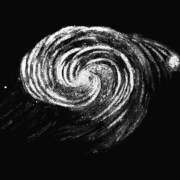From the Discovery of Uranus to the Astronomical Observatories of Ireland
Professor Michael Burton, Director of the Armagh Observatory and Planetarium
The image is a sketch of M51, the Whirlpool Galaxy, by William Parsons, 3rd Earl of Rosse in 1845.
William Herschel’s discovery of Uranus in 1781– the first new planet found by humanity since antiquity – made him famous overnight. It also profoundly changed our conception of the cosmos and stirred the imagination, a driver for the Enlightenment and the emergence of modern science.
The consequences were many, one of which was the founding of an observatory in Armagh, now the longest running observatory in the British Isles that has been continuously used for its original purpose – of exploring the cosmos.
Richard Robinson, Archbishop of Armagh and the Primate of All-Ireland, knew Herschel from the time he spent in Bath in the years following the discovery of Uranus. He was inspired to found Armagh Observatory in 1790 by it. A century later the famous “New General Catalogue of Nebulae and Clusters of Stars” (the NGC) was compiled in Armagh by its then Director, John Dreyer. The NGC is the successor to John Herschel’s General Catalogue, made using the Grubb 10” telescope in Armagh that still works today.
In Birr Castle, in County Offaly in Ireland, the 3rd Earl of Ross, William Parsons, was motivated by Herschel’s “40 foot” telescope to build his Great Telescope in 1845, with its 6-foot speculum mirror – the Leviathan – so succeeding Herschel’s 40 foot as the world’s largest telescope. Using it, and working with the Director of Armagh Romney Robinson, he uncovered the enigma of the spiral nebula, what we recognise today as other galaxies situated far beyond our own Milky Way,
Today the historic observatories of Ireland – Armagh, Birr and Dunsink (Dublin) – whose astronomers have worked closely together from their foundations – have come together as the Astronomical Observatories of Irelands with the aspiration to seek UNESCO World Heritage accreditation for their outstanding astronomical heritage, still very evident at the three sites today.
Each observatory also has ambitious plans for their sites. All are still active in scientific research and education in addition to their heritage, serving as beacons for the public communication of science in our challenged 21st century world, where many of the pressing problems faced by humanity must be tackled through the application of science.
As we approach the 250th anniversary of Herschel’s epoch-making discovery of Uranus in Bath – which will occur on the 13th of March in 2031 – it is timely to ask how might we mark this discovery and celebrate the achievements of all the Herschels in their pursuit of frontline science?
Professor Michael Burton is the Director of the Armagh Observatory and Planetarium as well as the President of the International Astronomical Union’s Commission C4 on “World Heritage and Astronomy”.
His own career in astronomy has followed in some of Herschel’s pioneering footsteps. It began in Edinburgh studying cosmic sources of infrared radiation (as first discovered by Herschel) using one of the first telescopes specially built for the infrared – the UKIRT in Hawaii.
Over the past decade he has been studying the structure of our Milky Way Galaxy – of which Herschel drew the first map – using radio telescopes in Australia in order to map out the giant clouds of molecules where stars are forming.
Today he runs both the Observatory and Planetarium in Armagh, where research & discovery, education & outreach, history & heritage all come together and contribute to a sense of place and civic pride in the community.
A link to a video recording of the lecture is available here.













